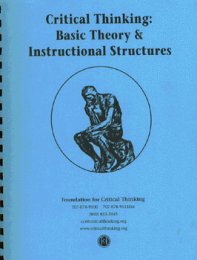
Gain digital access to this and many other resources at the Center for Critical Thinking Community Online!
(Physical copies not available at this time.)
Author: Richard W. Paul, Linda Elder
Publisher: Foundation for Critical Thinking
Copyright: 1999, revised 2000 edition
Pages: 148 Dimensions: 8.75" x 11" x .5" Weight: 1 lbs.
Binding: Spiral w/Soft
This handbook provides an outline of the most fundamental theory of critical thinking. In addition, it provides ideas for incorporating the theory into the structure of the curriculum. Included is theory on the elements of reasoning, intellectual standards, intellectual traits, content as a mode of thinking, the affective dimension of thinking, along with structures for student self-assessment, grading policies, and general tactical/ structural recommendations. This handbook is useful for understanding the basic theory, as well as for developing a curriculum with critical thinking at its very foundation.